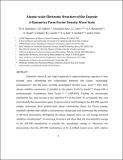Files in this item
Atomic-scale electronic structure of the cuprate d-symmetry form factor density wave state
Item metadata
| dc.contributor.author | Hamidian, M. H. | |
| dc.contributor.author | Edkins, Stephen David | |
| dc.contributor.author | Kim, Chung Koo | |
| dc.contributor.author | Davis, James C | |
| dc.contributor.author | Mackenzie, Andrew | |
| dc.contributor.author | Eisaki, H. | |
| dc.contributor.author | Uchida, S. | |
| dc.contributor.author | Lawler, M. J. | |
| dc.contributor.author | Kim, E.-A. | |
| dc.contributor.author | Sachdev, S. | |
| dc.contributor.author | Fujita, K. | |
| dc.date.accessioned | 2016-08-22T16:30:44Z | |
| dc.date.available | 2016-08-22T16:30:44Z | |
| dc.date.issued | 2016-02 | |
| dc.identifier | 239809038 | |
| dc.identifier | 6a65d9c0-af10-4421-b0c7-a9d06e05b194 | |
| dc.identifier | 84956759457 | |
| dc.identifier | 000369319500015 | |
| dc.identifier.citation | Hamidian , M H , Edkins , S D , Kim , C K , Davis , J C , Mackenzie , A , Eisaki , H , Uchida , S , Lawler , M J , Kim , E-A , Sachdev , S & Fujita , K 2016 , ' Atomic-scale electronic structure of the cuprate d -symmetry form factor density wave state ' , Nature Physics , vol. 12 , no. 2 , pp. 150-156 . https://doi.org/10.1038/nphys3519 | en |
| dc.identifier.issn | 1745-2473 | |
| dc.identifier.uri | https://hdl.handle.net/10023/9355 | |
| dc.description | Experimental studies were supported by the Center for Emergent Superconductivity, an Energy Frontier Research Center, headquartered at Brookhaven National Laboratory and funded by the US Department of Energy under DE-2009-BNL-PM015, as well as by a Grant-in-Aid for Scientific Research from the Ministry of Science and Education (Japan) and the Global Centers of Excellence Program for Japan Society for the Promotion of Science. C.K.K. acknowledges support under the FlucTeam Program at Brookhaven National Laboratory (Contract DE-AC02-98CH10886). S.D.E., J.C.D. and A.P.M. acknowledge the support of EPSRC through the Programme Grant ‘Topological Protection and Non-Equilibrium States in Correlated Electron Systems’. Theoretical studies at Cornell University were supported by the US Department of Energy, Office of Basic Energy Sciences, Division of Materials Science and Engineering under Award DE-SC0010313. Theoretical studies at Harvard University were supported by NSF Grant DMR-1103860 and by the Templeton Foundation. Research at Perimeter Institute is supported by the Government of Canada through Industry Canada and by the Province of Ontario through the Ministry of Research and Innovation. | en |
| dc.description.abstract | Research on high-temperature superconducting cuprates is at present focused on identifying the relationship between the classic ‘pseudogap’ phenomenon1,2 and the more recently investigated density wave state3,4,5,6,7,8,9,10,11,12,13. This state is generally characterized by a wavevector Q parallel to the planar Cu–O–Cu bonds4,5,6,7,8,9,10,11,12,13 along with a predominantly d-symmetry form factor14,15,16 (dFF-DW). To identify the microscopic mechanism giving rise to this state17,18,19,20,21,22,23,24,25,26,27,28,29, one must identify the momentum-space states contributing to the dFF-DW spectral weight, determine their particle–hole phase relationship about the Fermi energy, establish whether they exhibit a characteristic energy gap, and understand the evolution of all these phenomena throughout the phase diagram. Here we use energy-resolved sublattice visualization14 of electronic structure and reveal that the characteristic energy of the dFF-DW modulations is actually the ‘pseudogap’ energy Δ1. Moreover, we demonstrate that the dFF-DW modulations at E = −Δ1 (filled states) occur with relative phase π compared to those at E = Δ1 (empty states). Finally, we show that the conventionally defined dFF-DW Q corresponds to scattering between the ‘hot frontier’ regions of momentum-space beyond which Bogoliubov quasiparticles cease to exist30,31,32. These data indicate that the cuprate dFF-DW state involves particle–hole interactions focused at the pseudogap energy scale and between the four pairs of ‘hot frontier’ regions in momentum space where the pseudogap opens. | |
| dc.format.extent | 6062167 | |
| dc.language.iso | eng | |
| dc.relation.ispartof | Nature Physics | en |
| dc.subject | QC Physics | en |
| dc.subject | Physics and Astronomy(all) | en |
| dc.subject | DAS | en |
| dc.subject | BDC | en |
| dc.subject | R2C | en |
| dc.subject.lcc | QC | en |
| dc.title | Atomic-scale electronic structure of the cuprate d-symmetry form factor density wave state | en |
| dc.type | Journal article | en |
| dc.contributor.sponsor | EPSRC | en |
| dc.contributor.institution | University of St Andrews. School of Physics and Astronomy | en |
| dc.contributor.institution | University of St Andrews. Condensed Matter Physics | en |
| dc.identifier.doi | https://doi.org/10.1038/nphys3519 | |
| dc.description.status | Peer reviewed | en |
| dc.identifier.grantnumber | EP/I031014/1 | en |
This item appears in the following Collection(s)
Items in the St Andrews Research Repository are protected by copyright, with all rights reserved, unless otherwise indicated.

